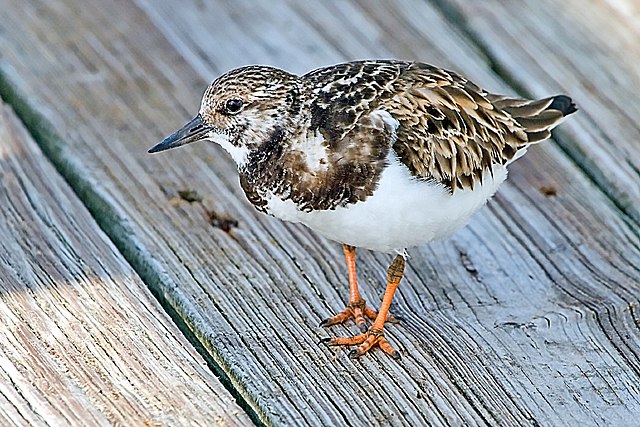Turnstone: Difference between revisions - Wikipedia
 Article Images
Article Images
Content deleted Content added
| (16 intermediate revisions by 14 users not shown) | |||
Line 1: {{ {{Automatic taxobox | image = Arenaria interpres.jpg Line 5: | image2 = Arenaria melanocephala.jpg | image2_caption = Black turnstone in winter plumage | taxon = Arenaria (bird) | synonyms = {{Species list |Arenarius|Dumont, 1805 Line 24: }} '''Turnstones''' are two [[bird]] [[species]] that The [[genus]] ''Arenaria'' was introduced by the French zoologist [[Mathurin Jacques Brisson]] in 1760 with the [[ruddy turnstone]] (''Arenaria interpres'') as the [[type species]].<ref>{{ cite book | last=Brisson | first=Mathurin Jacques | author-link=Mathurin Jacques Brisson | year=1760 | title=Ornithologie, ou, Méthode Contenant la Division des Oiseaux en Ordres, Sections, Genres, Especes & leurs Variétés | language=French, Latin | at=[https://biodiversitylibrary.org/page/36010447 Vol. 1, p. 48], [https://biodiversitylibrary.org/page/36294414 Vol. 5, p. 132] | place=Paris | publisher=Jean-Baptiste Bauche }}</ref><ref>{{ cite book | editor-last=Peters | editor-first=James Lee | editor-link=James L. Peters | year=1934 | title=Check-list of Birds of the World | volume= The genus contains two species: the [[ruddy turnstone]] (''Arenaria interpres'') and the [[black turnstone]] (''Arenaria melanocephala'').<ref name=ioc>{{cite web| editor1-last=Gill | editor1-first=Frank | editor1-link=Frank Gill (ornithologist) | editor2-last=Donsker | editor2-first=David | year=2019 | title=Buttonquail, plovers, seedsnipe, sandpipers | work=World Bird List Version 9.1 | url=https://www.worldbirdnames.org/bow/buttonquail/ | publisher=International Ornithologists' Union | ==Species==
[[File:Arenaria interpres (habitus).jpg|thumb|left|Ruddy turnstone in breeding plumage ===Ruddy turnstone=== ▲[[File:Arenaria interpres (habitus).jpg|thumb|left|Ruddy turnstone in breeding plumage.]] The [[ruddy turnstone]] (or just '''turnstone''' in [[Europe]]), ''Arenaria interpres'', has a circumpolar distribution, and is a very long distance migrant, wintering on coasts as far south as [[South Africa]] and [[Australia]]. It is thus a common sight on coasts almost everywhere in the world. It is one of the species to which the ''Agreement on the Conservation of African-Eurasian Migratory Waterbirds'' ([[AEWA]]) applies.▼ [[File:Arenaria melanocephala1.jpg|thumb|left|Black turnstone in summer plumage.]]▼ ▲The [[ruddy turnstone]] (or just '''turnstone''' in [[Europe]]), ''Arenaria interpres'', has a circumpolar distribution, and is a very long distance migrant, wintering on coasts as far south as [[South Africa]] and [[Australia]]. It is thus a common sight on coasts almost everywhere in the world. In breeding [[plumage]], this is a showy bird, with a black-and-white head, chestnut back, white underparts and red legs. The drabber winter plumage is basically brown above and white below. This is a generally tame bird and is an opportunist feeder. Unlike most waders, it will scavenge, and has a phenomenal list of recorded food items, including human corpses and [[coconut]]. The call is a staccato ''tuck- tuck- tuck''. ===Black turnstone===
▲[[File:Arenaria melanocephala1.jpg|thumb|left|Black turnstone in summer plumage
The [[black turnstone]] (''Arenaria melanocephala'') has a similar structure to its widespread relative, but has black upperparts and chest, and white below. It has a much more restricted range than the ruddy turnstone, breeding in western [[Alaska]], and wintering mainly on the [[Pacific Ocean|Pacific]] coast of the [[United States]]. Line 50 ⟶ 47: ==References== {{Reflist|refs= <ref name=thomasetal2004>{{cite journal|author1=Thomas, Gavin H. |author2=Wills, Matthew A. |author3=Székely, Tamás | <ref name=Wetmore>{{cite journal|author=Wetmore, Alexander|year=1937|title= The Eared Grebe and other Birds from the Pliocene of Kansas|journal=[[Condor (journal)|Condor]]|volume=39|issue=1|pages= 40|url=http://sora.unm.edu/sites/default/files/journals/condor/v039n01/p0040-p0040.pdf|doi=10.2307/1363487|jstor=1363487 }}</ref> }} ==External links== {{Commons category}}
{{Wikispecies|Corvus capensis}} * Ruddy turnstone = turnstone - [http://sabap2.adu.org.za/docs/sabap1/262.pdf Species text in ''The Atlas of Southern African Birds''] * [http://www.birds.cornell.edu/AllAboutBirds/BirdGuide/Ruddy_Turnstone.html Ruddy turnstone] – Cornell Lab of Ornithology * [http://www.mbr-pwrc.usgs.gov/id/framlst/i2830id.html Ruddy turnstone ''Arenaria interpres''] – USGS Patuxent Bird Identification InfoCenter * [https://www.youtube.com/watch?v=dbBzJ8xLpSY Turnstones feeding and bathing] {{Scolopacidae|1}} {{Charadriiformes|S.|state=collapsed}} {{Taxonbar|from=Q4865776}} [[Category: [[Category:Birds of the Arctic| ]] [[Category:Native birds of Alaska| ]] | |||